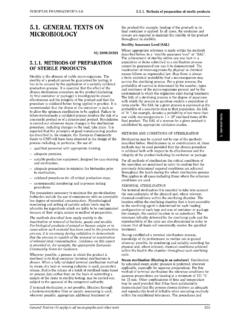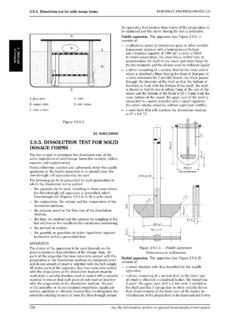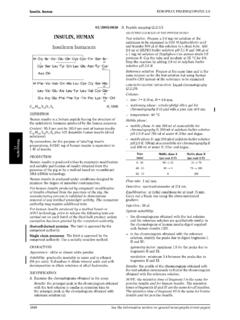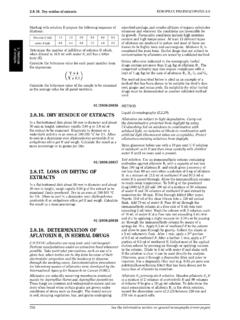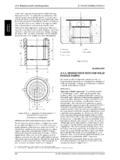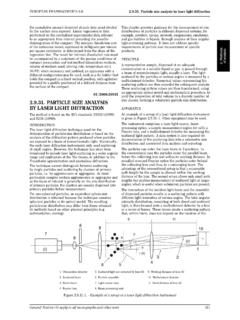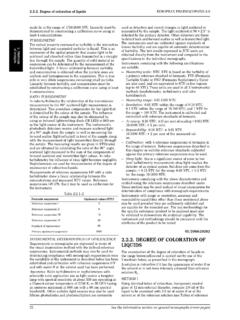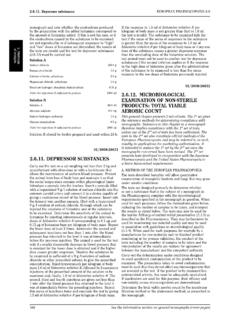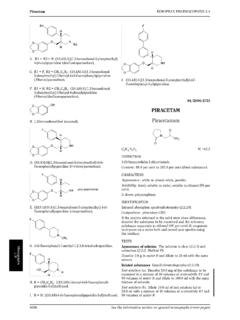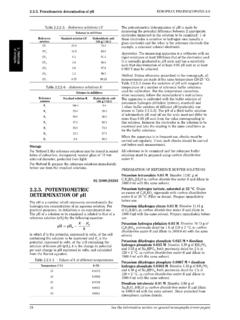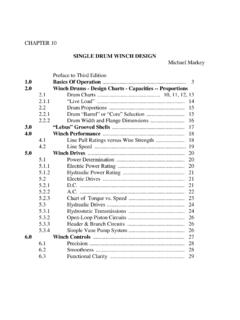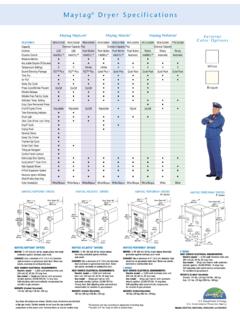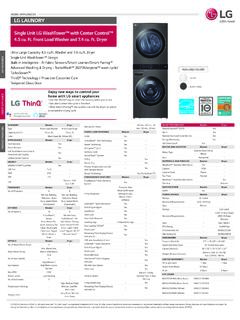Transcription of 2.9.6. UNIFORMITY OF CONTENT OF SINGLE-DOSE …
1 UNIFORMITY of CONTENT of SINGLE-DOSE preparationsEUROPEAN PHARMACOPOEIA UNIFORMITY OF CONTENT OFSINGLE-DOSE PREPARATIONSThe test for UNIFORMITY of CONTENT of SINGLE-DOSE preparationsis based on the assay of the individual contents of activesubstance(s) of a number of SINGLE-DOSE units to determinewhether the individual contents are within limits set test is not required for multivitamin and trace-elementpreparations and in other justified and Using a suitable analytical method, determine theindividual contents of active substance(s) of 10 dosage unitstaken at the criteria of test A, test B or test C as specified in themonograph for the dosage form in ATablets, powders for parenteral use, ophthalmic inserts,suspensions for injection.
2 The preparation complies withthe test if each individual CONTENT is between 85 per cent and115 per cent of the average CONTENT . The preparation fails tocomply with the test if more than one individual CONTENT isoutside these limits or if one individual CONTENT is outside thelimits of 75 per cent to 125 per cent of the average one individual CONTENT isoutside the limits of 85 percent to 115 per cent but within the limits of 75 per cent to125 per cent, determine the individual contents of another20 dosage units taken at random. The preparation complieswith the test if not more than one of the individual contentsof the 30 units is outside 85 per cent to 115 per cent of theaverage CONTENT and none is outside the limits of 75 per centto 125 per cent of the average BCapsules, powders other than for parenteral use, granules,suppositories, pessaries.
3 The preparation complies with thetest if not more than one individual CONTENT is outside thelimits of 85 per cent to 115 per cent of the average of 85 per cent to 115 per cent of the average contentor if one or more individual contents are outside the limits of75 per cent to 125 per cent of the average 2 or 3 individual contents are outside the limits of 85 percent to 115 per cent but within the limits of 75 per cent to125 per cent, determine the individual contents of another20 dosage units taken at random. The preparation complieswith the test if not more than 3 individual contents of the30 units are outside the limits of 85 per cent to 115 percent of the average CONTENT and none is outside the limits of75 per cent to 125 per cent of the average CTransdermal patches.
4 The preparation complies with thetest if the average CONTENT of the 10 dosage units is between90 per cent and 110 per cent of the CONTENT stated on thelabel and if the individual CONTENT of each dosage unit isbetween 75 per cent and 125 per cent of the average FRIABILITY OF UNCOATEDTABLETSThis test is intended to determine, under defined conditions,the friability of uncoated tablets, the phenomenon wherebytablet surfaces are damaged and/or show evidence oflamination or breakage when subjected to mechanical shockor a drum with an internal diameter between 283 and291 mm and a depth between 36 mm and 40 mm, made of atransparent synthetic polymer with polished internal surfacesandnotsubjecttostaticbuild-up( ).
5 Oneside of the drum is removable. The tablets are tumbled ateach turn of the drum by a curved projection with an insideradius between mm and mm that extends from themiddle of the drum to the outer wall. The drum is attachedto the horizontal axis of a device that rotates at 25 1 , at each turn the tablets roll or slide and fall onto thedrum wall or onto each tablets weighing up to g each, take a sample oftwenty tablets; for tablets weighing more than g each,take ten tablets. Place the tablets on a sieve no. 1000 andremove any loose dust with the aid of air pressure or a softbrush. Accurately weigh the tablet sample and place thetablets in the drum .
6 Rotate the drum 100 times and removethe tablets. Remove any loose dust from the tablets asbefore. If no tablets are cracked, split or broken, weigh thetablets to the nearest the test is run once. If the results are doubtful or ifthemasslossisgreaterthan1percent,repea tthetesttwiceand determine the mean of the 3 tests. A maximum loss of1 per cent of the mass of the tablets tested is considered tobe acceptable for most ,problemsof reproducibility may be encountered due to frequentirregular tumbling. In such cases, adjust the drum so thatthe tablets may fall freely and do not bind together whenlying next to each other, adjusting the drum so that the axisforms a 10 angle with the base is usually OF THE RESULTSThe friability is expressed as the loss of mass and it iscalculated as a percentage of the initial the number of tablets the information section on general monographs (cover pages)
